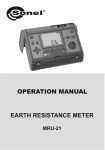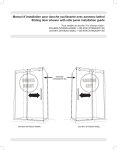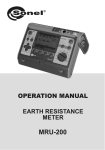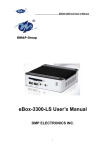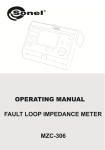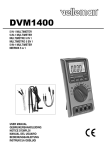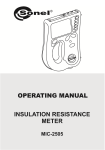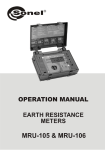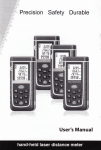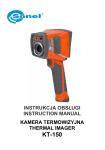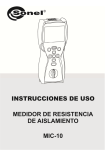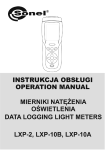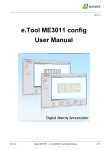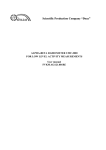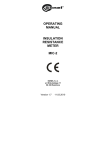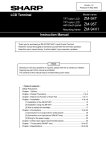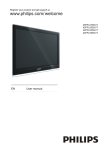Download User Manuals
Transcript
OPERATING MANUAL
EARTH RESISTANCE METER
MRU-20
SONEL SA
ul. Wokulskiego 11
58-100 Świdnica
Version 3.0 18/06/2014
The MRU-20 meter is a modern, easy and safe measuring device. Please acquaint yourself with the
present manual in order to avoid measuring errors and prevent possible problems related to operation
of the meter.
2
OPERATING MANUAL MRU-20 version 3.0
CONTENTS
1
SAFETY ...................................................................................................... 5
2
MEASUREMENTS .................................................................................... 6
2.1
2.2
2.3
2.4
2.4.1
2.4.2
3
MEASUREMENT OF RESISTANCE USING THREE-POLE METHOD ....................... 6
MEASUREMENT OF RESISTANCE USING DOUBLE-POLE METHOD, .................... 9
MEASUREMENT OF THE RESISTANCE OF PROTECTIVE CONDUCTORS AND
EQUIPOTENTIAL BONDINGS .......................................................................... 11
CALIBRATION OF TEST LEADS ...................................................................... 13
Activation of Autozeroing ........................................................................... 13
Switching-off Autozeroing .......................................................................... 14
POWER SUPPLY OF THE METER ..................................................... 16
3.1
3.2
3.3
MONITORING OF THE POWER SUPPLY VOLTAGE ........................................... 16
REPLACEMENT OF BATTERIES (RECHARGEABLE BATTERIES ) ...................... 16
GENERAL PRINCIPLES REGARDING USING NI-MH RECHARGEABLE
BATTERIES ................................................................................................... 18
4
CLEANING AND MAINTENANCE...................................................... 20
5
STORAGE ................................................................................................ 20
6
DISMANTLING AND UTILIZATION .................................................. 20
7
TECHNICAL DATA ................................................................................ 21
7.1
7.2
7.2.1
7.2.2
8
EQUIPMENT ........................................................................................... 24
8.1
8.2
9
BASIC DATA................................................................................................. 21
SUPPLEMENTARY DATA ............................................................................... 23
RE Measurement .......................................................................................... 23
Measurement of RCONT ................................................................................ 24
STANDARD EQUIPMENT............................................................................... 24
OPTIONAL EQUIPMENT ................................................................................ 24
MANUFACTURER ................................................................................... 26
OPERATING MANUAL MRU-20 version 3.0
3
4
OPERATING MANUAL MRU-20 version 3.0
1
Safety
MRU-20 meter is designed for measuring parameters important for safety of electrical installations. Therefore in order to provide conditions for correct operation and the correctness of the obtained results, the following recommendations must be observed:
Before you proceed to operate the meter, acquaint yourself thoroughly with this manual and observe the safety regulations and specifications defined by the producer.
MRU-20 meter is designed to measure earth resistance and the resistance of protective conductors and equipotential bondings. Any application that differs from those specified in the present
manual may result in a damage to the device and constitute a source of danger for the user.
The meter must be operated solely by appropriately qualified personnel members holding required certificates for carrying measurements in electric installations. Unauthorized use of the meter may result in its damage and may seriously endanger unauthorized user.
Using this manual does not exclude the need to comply with occupational health and safety regulations and with other relevant fire regulations required during the performance of a particular type
of work. Before starting the work with the device in special environments, e.g. potentially firerisk/explosive environment, it is necessary to consult it with the person responsible for health and
safety.
It is unacceptable to operate the following:
a damaged meter which is completely or partially out of order,
a meter with damaged test leads insulation,
a meter stored for an excessive period of time in disadvantageous conditions (e.g. excessive
humidity).If the meter has been transferred from a cool to a warm environment of a high level
of relative humidity, do not carry out measurements until the meter is warmed up to the ambient temperature (approximately 30 minutes).
Before commencing measurements, make sure the test leads are connected to the appropriate
measurement sockets.
Do not operate a meter with an open or incorrectly closed battery compartment or power it from
sources other than those specified in this manual.
The inputs of the meter are protected electronically against overload e.g. due to having been connected to a live circuit:
- for all combinations of inputs - up to 276V for 30 seconds.
Repairs may be carried out only by an authorized service point.
The device meets the requirements of standards EN 61010-1 and EN 61557-1, -4, -5.
Attention:
The manufacturer reserves the right to introduce changes in appearance, equipment and technical data of the meter.
Note:
An attempt to install drivers in 64-bit Windows 8 may result in displaying "Installation failed" message.
Cause: Windows 8 by default blocks drivers without a digital signature.
Solution: Disable the driver signature enforcement in Windows.
OPERATING MANUAL MRU-20 version 3.0
5
2
2.1
Measurements
Measurement of resistance using three-pole method
The three-pole measuring method is the basic type of resistance-to-earth measurement.
Disconnect earth
electrode being
tested from the
installation of
the building.
Turn on the meter.
Set the rotational function selector
set at RE 3p position.
Using Un button
set test voltage
on 25V or 50V.
After 5 sec. the
meter returns to
the measurement mode.
You can also
confirm the
choice by
pressing the
START pushbutton.
2,2m
ES H
The current electrode (driven into earth) should be connected to H socket of the meter.
The voltage electrode (driven into earth) should be connected to S socket of the meter.
The earth electrode being tested should be connected to E socket of the meter.
The earth electrode being tested and the current electrode and the voltage electrode should
be located one line
6
OPERATING MANUAL MRU-20 version 3.0
The meter is ready for
measurement.
Value of interference
voltage is displayed
on the auxiliary display
Press START button.
Carry out the measurement.
Value of interference voltage.
Read out main results:
earth electrode resistance RE.
Auxiliary results may be read
after pushing SEL push-button.
RH
resistance of current
electrode
RS
resistance of voltage
electrode
OPERATING MANUAL MRU-20 version 3.0
7
Value of additional
uncertainty caused by
resistance of the
electrodes.
S
Repeat the measurements (points 3-6) shifting the voltage electrode several meters:
the electrode should be shifted farther and
closer to the earth electrode being tested.
If RE measurement results differ from each
other by more than 3%, the distance of the
current electrode from the earth electrode
being tested should be considerably increased and the measurements should be
repeated
Note:
Measurement of resistance-to-earth may be carried out if voltage of interferences does not exceed 24 V. Voltage of interferences is measured up to the level
of 100 V but above 50 V it is signaled as dangerous The meter must not be
connected to voltages exceeding 100 V.
- Particular attention should be paid to quality of connection between the object being tested and the
test lead – the contact area must be free from paint, rust, etc.
- If resistance of test probes is too high, RE earth electrode measurement will be burdened with additional uncertainty. Particularly high uncertainty of measurement occurs when a small value of resistance-to-earth is measured with probes that have a weak contact with earth (such a situation occurs
frequently when the earth electrode is well made and the upper soil layer is dry and slightly conductive). In such a case, the ratio between resistance of the probes and resistance of the earth electrode
tested is very high and consequently, uncertainty of measurement that depends on this ratio is also
very high. Then according to guidelines defined in section 7 it is possible to calculate the effect of
measurement conditions - or to use the attached chart. This uncertainty is also displayed in [%] as an
additional result. It is calculated on the basis of measured valued. If such additional uncertainty exceeds 30% the following symbol is displayed with the measurement result
. You can improve the
contact between the probe and soil, for example, by dampening with water the place where the probe
is driven into earth, driving the probe into earth in a different place or using a 80 cm-long probe.
Check also the test leads for possible insulation damage and for corroded or loosened connection between the banana plug and the test lead. In majority of cases the measurement accuracy achieved is
satisfactory. However, you should always be aware of the uncertainty included in the measurement.
- Calibration performed by the manufacturer takes into account the resistance of supplied measurement lead of 2.2 m
8
OPERATING MANUAL MRU-20 version 3.0
Additional informations displayed by the meter
Interference voltage is too high (> 24V) – the measurement is impossible.
Turn off the source of interferences or try arrange probes
differently
and
and
and continuous audio
signal
and
and continuous audio
signal
with the name of
an electrode (or electrodes) and
and the measurement result and
>1,99kΩ
>50kΩ
and
and
long audio signal
and
2.2
Interference voltage is above 50V!
Immediately disconnect the meter!
Before re-connecting, turn off the source of voltage.
Interference voltage is above 100V!
Immediately disconnect the meter!
Before re-connecting, turn off the source of voltage.
Interruption in measuring circuit or resistance of test probes is higher than 60kΩ.
Please check connections in the measuring circuit or reduce the resistance of the measuring probe by its repositioning.
Uncertainty of RE measurement introduced by the resistance of test probes exceeds 30%. Reduce the resistance of the probe by its repositioning, or increase the dampness of the ground in the direct vicinity of the probe.
RE measuring range is exceeded .
Resistance of test probes is higher than 50kΩ (but lower
than 60kΩ).
Interference voltage is above 10V or unstable measurement result or measured voltages or currents are low in relation to noise.
Measured voltages or currents are too low in relation to
noise or very unstable measurement result. (Symbol
is displayed instead of the result.)
Acceptable temperature inside the meter is exceeded.
Measurement of resistance using double-pole method,
Turn on the meter.
Set the rotational function selector at RE 2p position.
OPERATING MANUAL MRU-20 version 3.0
9
UsingUn button
set test voltage
on 25V or 50V.
After 5 sec. the
meter returns
to the measurement mode.
You can also
confirm the
choice by
pressing the
START pushbutton.
E
H
2,2m
Connect the measured
object to terminalsE
and H of the meter.
1,2m
The meter is ready for
measurement.
Value of interference
voltage is displayed
on the auxiliary display.
Press START button.
Carry out the measurement.
Value of interference voltage.
Read out test results:
The value of measured
resistance.
Note:
- Calibration performed by the manufacturer takes into account the resistance of supplied measurement leads of 1.2 m and 2.2 m
10
OPERATING MANUAL MRU-20 version 3.0
Additional informations displayed by the meter
Interference voltage is too high (> 24V) – the measurement is impossible.
Turn off the source of interferences.
and
and
and continuous audio
signal
and
and continuous audio
signal
RE measuring range is exceeded.
Interference voltage is above 10V or unstable measurement result or measured voltages or currents are low in relation to noise.
and
and
long audio signal
and
Interference voltage is above 100V!
Immediately disconnect the meter. (symbol displayed instead of voltage value).
Before re-connecting, turn off the source of voltage.
Interruption in measuring circuit.
and
>1,99kΩ
Interference voltage is above 50V!
Immediately disconnect the meter!
Before re-connecting, turn off the source of voltage.
Measured voltages or currents are too low in relation to noise or very unstable measurement result. (Symbol
is
displayed instead of the result.)
Acceptable temperature inside the meter is exceeded.
2.3 Measurement of the resistance of protective conductors and
equipotential bondings
Attention:
When carrying out measurements of very low resistance, or when using leads other
than original (1.2 m and 2.2 m) the calibration of test leads must be performed.
Turn on the meter.
Set the rotational function selector at RCONT 200mA position.
OPERATING MANUAL MRU-20 version 3.0
11
Connect the
measured object
to terminals S and
E of the meter.
1,2m
E S
2,2m
The meter is ready
for measurement.
Press START button.
Carry out the measurement.
Read out the result.
Note:
- test current flows unidirectionally. To obtain results of a bidirectional current flow, the measurement
should be repeated with replaced test leads and then respective arithmetic mean should be calculated
from both measurements.
12
OPERATING MANUAL MRU-20 version 3.0
Additional informations displayed by the meter
Interference voltage is too high (> 3Vrms) – the measurement is impossible.
Turn off the source of interferences.
and
and
and continuous audio
signal
Interference voltage is above 50V!
Immediately disconnect the meter!
Before re-connecting, turn off the source of voltage.
RCONT measuring range is exceeded.
Interference voltage with value of 1..3Vrms during RCONT
measurement. Obtained test results may be burdened with
additional uncertainty.
> 199Ω
and
and
long audio signal
Very unstable measurement result.
2.4
Calibration of test leads
In order to eliminate the impact of the resistance of test leads on measurement result, the compensation (autozeroing) of resistance may be performed. Therefore measurement function RCONT has
its sub-function called AUTOZERO.
2.4.1 Activation of Autozeroing
Turn on the meter.
Set the rotational function selector at RCONT ZERO position.
Short the test leads by
putting crocodile clips
on exposed ends of the
test leads.
ES
Press START button.
Perform Autozeroing.
OPERATING MANUAL MRU-20 version 3.0
13
Autozeroing
performed.
Note:
- remember that the resistance of crocodile clips and crocodile-banana connections is added to the
resistance of the test leads.
2.4.2 Switching-off Autozeroing
Turn on the meter.
Set the rotational function selector at RCONT ZERO position.
Open out the test leads.
ES
Press START button.
Autozeroing was turned
off by the user.
During measurements
the meter will compensate the resistance of original test leads (1.2m and
2,2m.)
14
OPERATING MANUAL MRU-20 version 3.0
Attention:
It is sufficient to perform single compensation for the test leads. It is stored in
memory even after turning off the meter.
OPERATING MANUAL MRU-20 version 3.0
15
3
3.1
Power supply of the meter
Monitoring of the power supply voltage
The level of the charge of the batteries or rechargeable batteries is currently indicated by the
symbol in the right upper corner of the display:
Batteries (or rechargeable batteries) charged
Batteries (or rechargeable batteries) low.
Batteries (or rechargeable batteries) need charging!
Note:
The symbol
displayed on the display indicates insufficient power supply voltage and the need
to charge or replace batteries.
Measurements carried out with insufficient meter power supply voltage are distorted with additional errors which are impossible to ascertain by the user and thus they cannot constitute a basis
for a conclusion of correctness of the tested earthing.
3.2
Replacement of batteries (rechargeable batteries)
MRU-20 Meter is powered by eight batteries or rechargeable batteries R6 (it is recommended to
use alkaline batteries). Batteries (rechargeable batteries) are inserted into a container in the bottom
part of the casing.
WARNING:
Before replacing the batteries (or rechargeable batteries), disconnect the test
leads from the meter.
In order to replace batteries or the set of rechargeable batteries it is necessary to do the following:
1. Remove all the test leads from the measurement circuit and turn the meter off,
2. Remove the battery compartment (in the bottom of the case) after loosening three screws,
3. Replace all batteries (rechargeable batteries). New batteries or rechargeable batteries must be
inserted observing the correct polarity ("-" on the springy part of the contact plate). Incorrect position of batteries will not damage the meter or batteries, but the meter with incorrectly inserted batteries will not work.
4. Insert the battery compartment and fix it with screws.
16
OPERATING MANUAL MRU-20 version 3.0
After replacing batteries/ rechargeable batteries the meter, after switching it on, will operate in power supply selection
mode.
Selected power supply: rechargeable batteries.
Pressing SEL push-button will change the power supply to
batteries.
Another pressing of the push-button will switch
the selection again to rechargeable batteries.
OPERATING MANUAL MRU-20 version 3.0
17
Pressing START push-button will confirm the choice
and the meter will be ready for measurement.
NOTE!
After replacing batteries (rechargeable batteries), set the type of power supply
in order to enable correct display of battery charging level (charging characteristics of batteries and rechargeable batteries are different).
NOTE!
If batteries leak inside the battery compartment the meter should be serviced.
Rechargeable batteries should be charged in an external charger.
3.3
General principles regarding using Ni-MH rechargeable batteries
- If you do not use the device for a prolonged period of time, then it is recommended to remove the
rechargeable batteries and store them separately.
- Store the rechargeable batteries in a dry, cool and well ventilated place and protect them from direct
sunlight. Ambient temperature in case of prolonged storage should not exceed 30°C. If the rechargeable batteries are stored for a long time in a high temperature, then occurring chemical processes
may reduce their lifetime.
- NiMH rechargeable batteries are usually last for 500-1000 charging cycles. This rechargeable batteries reach their maximum capacity after being formatted (2-3 charge and discharge cycles). The most
important factor which influences the lifetime a rechargeable battery is the level of its discharging. The
deeper the discharge level, the shorter lifetime of a rechargeable battery.
- The memory effect is limited in case of NiMH rechargeable batteries. These rechargeable batteries
may be charged at any point with no serious consequences. However, it is recommended to discharge them completely every few cycles.
18
OPERATING MANUAL MRU-20 version 3.0
- During storage, Ni-MH rechargeable batteries are discharged at the rate of approximately 30% per
month. Storing rechargeable batteries in high temperatures may increase this rate even to 60%. In
order to prevent excessive discharge of rechargeable batteries, after which it would be necessary to
format them, it is recommended to charge the accumulators from time to time (even if not used).
- Modern quick-chargers detect both too low and too high temperature of rechargeable batteries and
they react to this situation adequately. When the temperature is too low, charging is prevented as it
may irreparably damage rechargeable batteries. Increased temperature of rechargeable batteries is a
signal to stop charging and it is a typical phenomenon. However charging at high ambient temperatures reduces the lifetime of batteries and causes faster increase of their temperature, preventing charging to the full capacity.
- Remember that in the case of quick charging, rechargeable batteries are charged to approximately
80% of their capacity; better results may be obtained if the process of charging is continued: the
charger goes then to the phase of charging with a low current and after next couple of hours the rechargeable batteries are charged to their full capacity
- Do not charge or use rechargeable batteries in extreme temperatures. Extreme temperatures reduce
the lifetime of batteries and rechargeable batteries. Avoid locating devices powered by rechargeable
batteries in very hot places. The nominal working temperature must be absolutely observed.
OPERATING MANUAL MRU-20 version 3.0
19
4
Cleaning and maintenance
NOTE!
Apply only maintenance methods specified by the manufacturerin this manual.
The casing of the meter and its case may be cleaned with a soft, damp cloth using all-purpose
detergents. Do not use any solvents or cleaning agents which might scratch the casing (powders, pastes, etc.).
Clean the probes with water and dry it. Before the probes are stored for a prolonged period of time
it is recommended to grease them with any machine lubricant.
The reels and test leads should be cleaned with water and detergents, and then dried.
The electronic system of the meter does not require maintenance.
5
Storage
The following recommendations must be observed to ensure proper storing of the device:
Disconnect all the test leads from the meter.
Clean the meter and all its accessories thoroughly.
Wind the long test leads onto the reels.
If the meter is to be stored for a prolonged period of time, the batteries must be removed from the
device.
in order to prevent total discharge of the rechargeable batteries during prolonged storage, charge
them from time to time.
6
Dismantling and utilization
Worn-out electric and electronic equipment should be collected selectively, i.e. it must not be disposed with waste of another kind.
Worn-out electronic equipment should be sent to a collection point in accordance with regulations
related to Waste Electrical and Electronic Equipment.
Before the equipment is sent to a collection point, do not attempt to dismantle any elements.
Observe the local regulations concerning disposal of packages, worn-out batteries and accumulators.
20
OPERATING MANUAL MRU-20 version 3.0
7
Technical data
Specified accuracy relates to terminals of the meter.
„m.v.” abbreviation indicated standard measured value.
7.1
Basic data
Measurement of resistance-to-earth RE
Measurement method: technical, according to IEC 61557-5
Test range according to IEC 61557-5: 0,50 ... 1,99k for Un=50V
0,68 ... 1,99k for Un=25V
Ranges
of display
0,00...9,99
10,0...99,9
100...999
1,00...1,99k
Resolution
Basic uncertainty
0,01
0,1
1
0,01k
(2% m.v. + 3 digits)
In the three-pole method, the uncertainty caused by resistance of probes is calculated and displayed by the meter. It can also be estimated using the following chart:
Additional uncertainty
of probes
[%]
caused
resistance
Błąd dodatkowy
od by
rezystancji
elektrod
[%]
100,0000
RH/RE=3000
10,0000
RH/RE=1000
RH/RE=300
1,0000
RH/RE=100
RH/RE=30
0,1000
RH/RE=10
R
a elektrody
pr ądowej
RHH Rezystancj
Current electrode
resistance
R
Rezystancj
a uziemienia
RE
Earth resistance
RH/RE=3
0,0100
RH/RE=1
E
RH/RE=0,3
0,0010
1
10
100
1000
Rezystancja
elektrodyresistance
napięciowejRs[]
Rs[]
Voltage electrode
10000
100000
Influence of the resistance of electrodes on measurement uncertainty
OPERATING MANUAL MRU-20 version 3.0
21
Measurement of auxiliary electrodes resistance RH, RS
Ranges
of display
000...999
1,00...9,99k
10,0...50,0k
Resolution
Basic uncertainty
1
0,01k
0,1k
(5% (RS + RE + RH) + 3 digits)
Measurement of interference voltages
Internal resistance: approx. 100k
Range
0...100V
Resolution
1V
Basic uncertainty
(2% m.v. + 3 digits)
Measurement of RCONT
Measurement method: technical
Test range according to IEC 61557-4: 0,13…199
Display range
0,00...9,99
10,0...99,9
100...199
Resolution
0,01
0,1
1
Basic uncertainty
(2% m.v. + 3 digits)
Note: Only values containing tolerances or boundary values are considered as guaranteed data. Values without tolerances are for informational purposes only.
Other technical data
a) type of insulation .................................................... double, according to EN 61010-1 and IEC 61557
b) measurement category .................................................................. IV 300V according to EN 61010-1
c) degree of housing protection acc. to EN 60529 .......................................................................... IP54
d) maximum voltage of interferences at which RE measurement is performed ................................. 24V
e) maximum voltage of interferences at which RCONT measurement is performed .............................. 3V
f) maximum measured voltage of interferences ............................................................................ 100V
g) frequency of RE test current .................................................................................................... 125 Hz
h) test voltage RE .................................................................................................................. 25V or 50V
i) test current RE .......................................................................................................................... 20mA
j) maximum resistance of test electrodes ..................................................................................... 50k
k) RCONT measuring current (with shorted terminals for UBAT 9,0V) .......................................... 200mA
l) maximum voltage on open terminals for RCONT ............................................................................ 13V
m) power supply of the meter ........... alkaline batteries or NiMH rechargeable batteries, size AA (8 pcs)
n) number of RE measurements .....................................................> 1000 (5, 2 measurements /min.)
o) dimensions ............................................................................................................... 260x190x60 mm
p) weight of the meter with batteries ................................................................................ approx. 1.3 kg
q) display ............................................................................................................... LCD with a backlight
r) working temperature ......................................................................................................... -10..+55C
s) nominal temperature........................................................................................................... +23 ± 2C
t) storage temperature ...................................................................................................... -20C..+70C
u) time of automatic switch-off, 5 minutes...............................................................................................
v) electromagnetic compatibility ..................................... according to EN 61000-6-3 and EN 61000-6-2
w) quality standard, execution, design and manufacturing are ISO 9001 compliant
22
OPERATING MANUAL MRU-20 version 3.0
7.2
Supplementary data
Data on additional uncertainties are useful mainly when the meter is used in non-standard conditions and for meteorological laboratories during calibration.
7.2.1 RE Measurement
7.2.1.1 Additional uncertainty caused by resistance of auxiliary electrodes
RS
R 0,004
150 H
1,5 108 RH2
100000
R
R
S
E
dod
dod 7,5
RH 0,004
1,5 108 RH2
RE
%
%
RS < 5k
RS ≥ 5k
RE, RH and RS are values indicated by the meter in [.The above uncertainty is calculated by the
meter and displayed as ER.
7.2.1.2 Additional uncertainty caused by serial interference voltage
RE
0,00...9,99
10,0...99,9
100...1,99k
Additional uncertainty []
±(0,01RE + 0,012)Uz ± 0,003Uz2
±(0,001RE + 0,05)Uz ± 0,001Uz2
±(0,001RE + 0,5)Uz ± 0,001Uz2
7.2.1.3 Additional uncertainty caused by ambient temperature:
± 0,25 digits /°C
7.2.1.4 Additional uncertainties according to IEC 61557-5
Operational uncertainty or
significant parameter
Supply voltage
Reference conditions or
range of use
Reference
position ±90°
Unom ÷ Umin
Temperature
0 ÷ 35°C
E3
Serial
interference voltage
3V
E4
Resistance of probes and
auxiliary earth electrodes
From 0 to 100RE, but ≤
50kΩ
E5
Position
Operational uncertainty
Designation
Additional
uncertainty
E1
0
E2
0
according to
the formula
defined in
7.2.1.3
according to
the formula
defined in
7.2.1.2
according to
the formula
defined in
7.2.1.1
B A 1,15 E12 E22 E32 E42 E52
where A = basic uncertainty
OPERATING MANUAL MRU-20 version 3.0
23
7.2.2 Measurement of RCONT
7.2.2.1 Additional uncertainty caused by ambient temperature:
±0,15%/°C
7.2.2.2 Additional uncertainties according to IEC 61557-4
Operational uncertainty or
significant parameter
Supply voltage
Reference conditions or
range of use
Reference
position ±90°
Unom ÷ Umin
Temperature
0 ÷ 35°C
Position
Designation
Additional
uncertainty
E1
0
E2
0
according to
the formula
defined in
7.2.2.1
E3
B A 1,15 E12 E22 E32
where A = basic uncertainty
Operational uncertainty
8
Equipment
8.1 Standard Equipment
Standard set of equipment supplied by the manufacturer includes:
MRU-20 meter – WMPLMRU20,
AA batteries (8 pcs)
set of test leads:
lead (30m), red, on a reel, ended with banana plugs – WAPRZ030REBBSZ,
lead (15m) on a reel, ended with banana plugs – WAPRZ015BUBBSZ,
lead (2.2m), black, ended with banana plugs– WAPRZ2X2BLBB,
lead (1.2m) blue, ended with banana plugs WAPRZ1X2REBB,
crocodile clip, blue K02 – WAKROBU20K02,
crocodile clip, black K01 – WAKROBL20K01,
earth contact test probe (rod) 30cm (2 pcs) – WASONG30,
carrying case for the meter and its equipment – WAFUTL4,
harness for the meter – WAPOZSZE2,
operating manual,
calibration certificate.
8.2 Optional Equipment
Additionally, the following items not included in the scope of standard equipment may be purchased from the manufacturer or the distributors:
24
OPERATING MANUAL MRU-20 version 3.0
WAPRZ025BUBBSZ
WAFUTL3
probe protective cover 80cm
cramp
Test lead, 25m (blue)
WAPRZ050YEBBSZ
Test lead 50m
WAPOZSZP1
LSWPLMRU20
calibration certificate
reel for winding test leads
WASONG80
earth contact test probe (rod) (80 cm)
OPERATING MANUAL MRU-20 version 3.0
25
9
Manufacturer
The manufacturer of the device, which also provides guarantee and post-guarantee service is the
following company:
SONEL S.A.
ul. Wokulskiego 11
58-100 Świdnica
Poland
tel. +48 74 858 38 60
fax +48 74 858 38 09
E-mail: [email protected]
Web page: www.sonel.pl
Attention:
Service repairs must be realized only by the manufacturer.
26
OPERATING MANUAL MRU-20 version 3.0
































